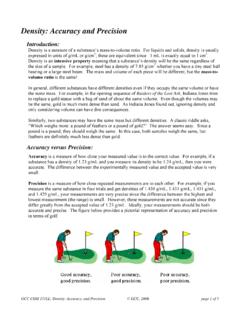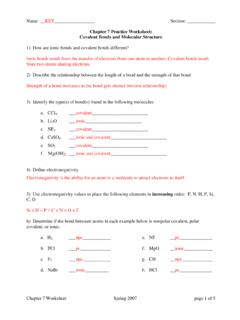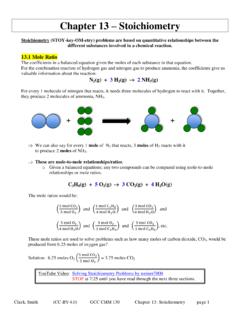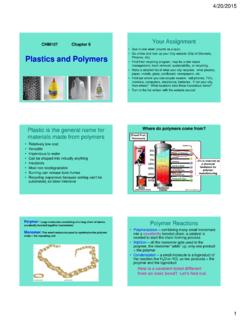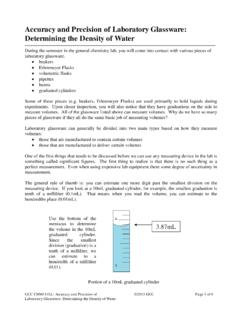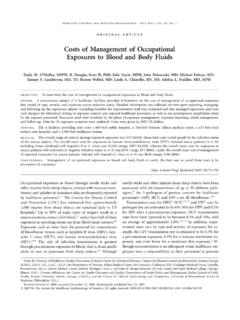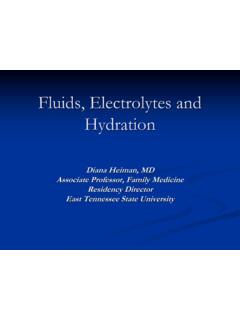Transcription of CHM 130LL: Electrolytes - Welcome to web.gccaz.edu
1 GCC CHM 130ll Spring 2016 page 1 of 7 Introduction Electrolytes are substances that conduct electricity in solution. In this experiment, you will use a conductivity tester to determine whether substances are strong, weak, or non- Electrolytes . The conductivity tester has red and green LEDs that will light up if a solution contains ions that will conduct electricity. Ions can carry electricity across a solution between the electrodes. A strong electrolyte will completely dissociate into ions in solution and will cause a strong or bright light. A weak electrolyte will only dissociate to a small degree. Only a small percentage of the compounds will dissociate into ions but most will stay together as intact molecules, and a weak light will be seen.
2 Non- Electrolytes will not dissociate into ions at all and will not conduct electricity. It is important to know the difference between ionic and covalent compounds in this lab. Ionic compounds are generally metal cations bonded with nonmetal anions. Covalent compounds are composed of nonmetal atoms covalently bonded together. Background The best everyday example of an electrolyte is Gatorade or any similar sports drink. When you exercise, you lose Electrolytes through sweat. In order to maintain normal cell function, it is crucial that those Electrolytes be replaced. Electrolytes are used by your body to regulate functions such as heartbeat, brain function, and muscle control.
3 The most common Electrolytes that must be kept in balance in your body are sodium, potassium, magnesium, calcium, chloride, and bicarbonate. Sodium is responsible for regulating the electrical signals to your brain, muscles, and nervous system. Most of your body s fluid (outside the cells; , blood and urine) is high in sodium. It is possible to have too much sodium (hypernatremia) or too little sodium (hyponatremia) in your system. Potassium is the major electrolyte found in cells. One of the main roles of potassium is in the regulation of your heartbeat and muscle function. It is common for athletes who are experiencing muscle cramps to consume potassium (bananas are a great source).
4 Like sodium, it is possible to have increased potassium levels (hyperkalemia) or decreased potassium levels (hypokalemia). Potassium is not lost as rapidly as sodium since it is inside cells. Chloride is also a major electrolyte in the body . Like sodium it is found mainly in body fluids outside the cells. Human body fluids have almost the same concentration of chloride ions as sea water. Bicarbonate acts as a buffer in the body to help control the pH of your blood and other fluids. Figure 1 to the right illustrates the difference between an electrolyte (left picture) and a non- electrolyte (right picture). Picture from McMurry/Fay 5th edition, Pearson CHM 130ll : Electrolytes Lab GCC CHM 130ll Spring 2016 page 2 of 7 Understanding solubility rules: Water is commonly used as a solvent in solutions.
5 When a substance is soluble in water, it is said to be aqueous. The notation (aq) is used for the physical state and specifically means that substance will dissolve in water. Solubility rules for ionic compounds are on your Periodic Table. If an ionic compound will dissociate, or break into ions, it is soluble. If is will not break into ions then it is said to be largely insoluble (very few ions form.) When an ionic compound with a polyatomic ion dissociates and breaks into ions, the polyatomic ion stays together. For example, in potassium sulfate, K2SO4 which is soluble, the ions are two K+ and one SO42- ions. See the beaker above. Do not separate the S and O atoms in sulfate ion.
6 Strong Electrolytes : A strong electrolyte will completely dissociate (break apart) into ions in solution and will cause a strong or bright light. Soluble ionic compounds are strong Electrolytes . One example is potassium fluoride (KF) dissolved in water. If you check the solubility rules on your Periodic Table, potassium ions are always soluble. This means that potassium compounds will always break apart completely (100%) into ions in water. We can represent this as shown in the picture to the right. (Also see the left image in Figure 1.) Notice that once the solid is placed in water it breaks apart into separate ions that have charges. These charges help us write the correct chemical formula for ionic compounds.
7 Strong acids and bases are also strong Electrolytes . Watch the movie at this link ( ) to see an animation of sodium chloride dissolving in water. Weak Electrolytes fall between strong and non- Electrolytes . Weak acids and bases are the most common examples of weak Electrolytes . Insoluble ionic compounds are also weak Electrolytes as they are very slightly soluble in water, and dissociate into a few ions. As you might guess, these will usually give a weak light when placed in a conductivity tester. The reason is that these substances will dissociate into ions to a small degree (1-5%). Since most of the compounds will stay together in molecular form, there aren t as many ions floating around in solution.
8 Therefore, they can only conduct electricity to a small degree, and that is why a weak light is seen. Notice in the drawing of hydrofluoric acid on the right how only one molecule out of five (or 20%) is dissociated into ions. In reality, most weak acids and bases only dissociate about 1-5%. Watch the animation at this link to see a strong acid versus a weak acid ionizing in water. Non- Electrolytes do not break apart into ions. These substances are usually covalently bonded molecules (non-metal + non-metal like C6H12O6). Water molecules are not strong enough to pull the compounds apart into ions and therefore they will not conduct electricity. (See the right image in Figure 1.)
9 The image to the right illustrates what you would see if you could zoom in to the atomic level. Notice that the molecules stay intact in the beaker: there are no ions at all. They are not broken apart by water. Also notice that this is a covalent molecule. GCC CHM 130ll Spring 2016 page 3 of 7 Summary: In general: Strong Electrolytes strong acids, strong bases, soluble ionic compounds Weak Electrolytes weak acids, weak bases, insoluble ionic compounds Non- Electrolytes molecular or covalent compounds Procedure: Half of the lab (in pairs) will measure Electrolytes while the other half (again in pairs) works on the post lab questions.
10 Part I Determining strengths of Electrolytes 1. Make sure the well plate is clean and dry. (It is crucial that the wells are clean and dry because any contamination will give incorrect results.) 2. Notice that each row on the well plate is labeled with letters and each column is labeled with numbers. This makes it possible to identify which substance is in which well (ex: A3 or C2). In your data table (on the next page), write which well you will place each substance in. 3. For the solid salt (NaCl) and solid sugar (C12H22O11) use those bottles to carefully fill two wells about full of each solid making sure no crystals spill over into a different well.

